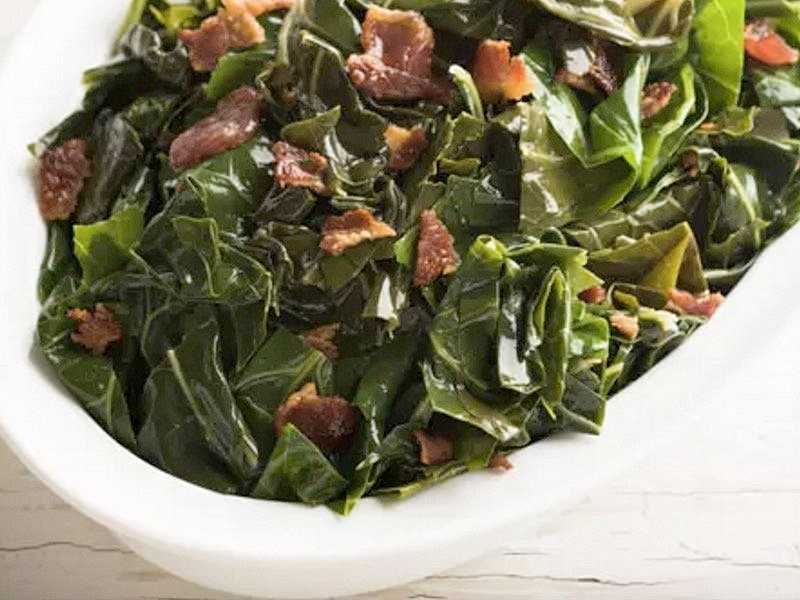The internet was set ablaze in recent weeks as news spread that luxury retailer Neiman Marcus was selling trays of collard greens for $66.
Built for the holiday table, the fully cooked greens, "seasoned with just the right amount of spices and bacon," arrive packed in four 12-ounce trays and were advertised as enough to feed eight to 10 guests. With shipping, the frozen, ready-to-reheat dish sold for $81.50.
To offer some perspective, a dinner portion of prepared greens from Chic Cafe Downtown costs $3.50. And you can have them delivered to you – even eight to 10 servings – for an added cost of about $3. A family-sized portion of collard greens from Nino's Southern Sides in Shorewood is $11.49.
The costly dish isn’t unusual for the retailer, which releases its Christmas Book each fall. The catalog is filled with myriad holiday gift ideas (mostly luxury items), including some particularly outrageously priced options, like a Cobalt Valkyrie-X Private Plane in rose gold for $1.5 million.
But the greens hit a nerve. Posts about the offering went viral, with many accusing the retailer of appropriating black culture, inciting a new hashtag: #gentrifiedgreens.
.jpg)

NPR covered it. The Boston Globe covered it. CBS News covered it. Here in the Midwest, Minneapolis-based soul food chefs were not amused. And neither were the folks at The Root.
"I can't even begin to imagine the conversation at the dinner table with my grandmother," said Yesha Callahan of The Root. "Do you know how many pounds of greens you could get for $66 at a grocery store? And who's cooking these greens? Is there some secret Neiman Marcus kitchen run by a grandmother or Paula Deen?"
They’ve also noted they plan to follow up with a review of the spendy greens, which gained even more traction this weekend when NM announced that the product was sold out.

Regardless of your perspective, the sheer interest generated by the NM offering is worthy of note. Because in the end, there’s always an opportunity for conversation and understanding about why something as simple as collard greens strikes a chord for so many.
Is it right for someone to re-market a Southern soul food dish as a luxury item? Maybe more so, is it right for them to make a huge profit on food that owes its popularity largely to the the creativity of black Southerners?
Maybe none can speak to it more eloquently than food historian Michael Twitty, who wrote a piece about collard greens last year after Whole Foods published a recipe for the Southern staple without a reference to the dish’s cultural history.
In the end, his message resonates:
‘‘This food connects us to the globe. It connects us to Africa. It connects us to slavery, to freedom, to sharecropping, to migration, to triumph, to survival. It’s a powerful symbol of our history, our social identity, and the cultural politics we negotiate our lives by [...] You don’t have to be Jewish to eat Levy’s Rye, and you don’t have to be ‘Colored’ to love collards, but this is the key ... being culturally aware needs to be a value in our society – for all of us,’’ he wrote.
It should give us all some food for thought.
As a passionate champion of the local dining scene, Lori has reimagined the restaurant critic's role into that of a trusted dining concierge, guiding food lovers to delightful culinary discoveries and memorable experiences.
Lori is an avid cook whose accrual of condiments and spices is rivaled only by her cookbook collection. Her passion for the culinary industry was birthed while balancing A&W root beer mugs as a teenage carhop, fed by insatiable curiosity and fueled by the people whose stories entwine with every dish. Lori is the author of two books: the "Wisconsin Field to Fork" cookbook and "Milwaukee Food". Her work has garnered journalism awards from entities including the Milwaukee Press Club. In 2024, Lori was honored with a "Top 20 Women in Hospitality to Watch" award by the Wisconsin Restaurant Association.
When she’s not eating, photographing food, writing or planning for TV and radio spots, you’ll find Lori seeking out adventures with her husband Paul, traveling, cooking, reading, learning, snuggling with her cats and looking for ways to make a difference.






